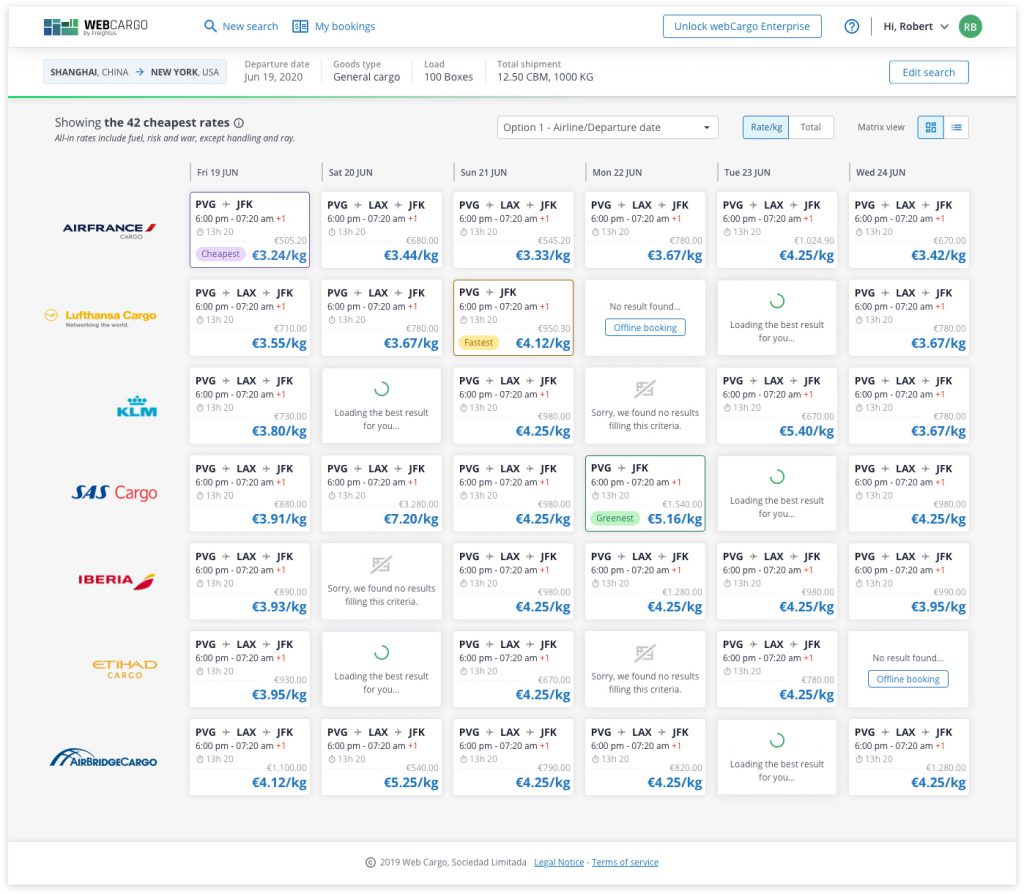What Is eBooking: The Three Things Your eBooking Platform Must Have

Here at WebCargo, we are seeing eBookings growing at a CAGR of over 400%. As the industry rapidly shifts online, feedback from forwarders and carriers alike has been overwhelmingly positive, with reports about time saved, a more streamlined user experience, and faster turnaround times for cargo bookings.
It’s no wonder that eBookings are all the rage in the air cargo world, with carriers like Air France/KLM, IAG Cargo, SAS, Lufthansa, and United Cargo modernizing their cargo operations to provide eBooking capability and forwarders like Sinotrans are even rolling eBooking out to their users, too. There are many platforms now offering the service, and all seem to be providing the same service to their users. A little digging, though, reveals this may not be the case.
This article explores the underlying goal of eBookings, core business impacts when eBooking isn’t digitally integrated, and three core requirements for eBooking platforms.
eBooking: Experience, or method?
Consider the last time you booked a hotel room on a website. You were presented with a sleek interface which provided you all the relevant information you need about the hotel, rooms, prices, availability, and such. You selected the room, filled out the form, clicked the button – and presto, you reserved your room.
But what about what happened behind the scenes?
The information you were presented with was pulled in real time from the hotel’s database. The reservation request was sent, in real time, to that database, which processed the request and sent the confirmation back to you (through the website you used), in real time. All of this was created and processed by information flowing back and forth across the Web.
If the website did not use real time connectivity to process bookings, a booking request would lead to a call to the hotel’s booking manager, who reserved your room and sent you your confirmation.
Would this be considered eBooking? If you go by the experience, sure. After all, from what you saw, you booked a hotel room on a website. It was quick and easy.
But it wasn’t. And that comes at a cost. Using an electronic interface to submit a booking request doesn’t make it an eBooking.
The “e” in eBooking can either refer to the experience you have in making your booking, or the method in which the booking was transacted across all parties.
The difference lies in speed, data accuracy, and the level of connectivity a user has with the end supplier.
Real-time speed, data accuracy, and direct connectivity
Let’s get back to air cargo eBookings.
A forwarder logs onto an air cargo eBooking platform to create a shipment on behalf of a customer. They see bookable rates from carriers servicing the route, click a button, submit the shipment information, and wait for a confirmation if their shipment has been accepted.
If the platform is truly digital, the prices are, by definition, guaranteed and up to date. Capacity information is also accurate and updated automatically. And, when a booking is submitted, it goes straight to the airline. In short, a forwarder can rely on perfect data accuracy, executed both ways in real-time.
This is where a digital frontend with a manual backend differs.
The forwarder may have a digital booking experience – but they aren’t booking digitally. Their booking requires manual intervention. In a manual air cargo booking process, data could be retyped up to 97 times (!!!) in order to complete a shipment. Mistakes can be made – it’s actually a wonder so many shipments actually succeed.
But the underlying data from the airline may be inaccurate too.What you see on the website is not necessarily 100% accurate in real time. Accuracy and on-demand data unlocks speed. When this is amplified across dozens or hundreds of shipments a day, it has major impacts on efficiency. And, of course, when it’s not available, customers suffer. Forwarders negotiating spot rates with airlines wait an average of 67 hours to receive a response – and when that shipment is time-sensitive, everyone loses.
Truly digital eBooking solves for this. For example, forwarders using WebCargo, on the other hand, report being able to quote customers up to 65% faster along with faster closing times.
Accuracy hurts in more ways than just getting goods to their final destination. Data inaccuracy costs logistics providers more than $250m per year in revenue leakage. Some carriers’ invoice adjustment rates for CASS settlements are reaching 20%. 9 percent of the AWBs processed by CNS are disputed. These disputes take time and money to resolve, and their effects on customer experience and customer retention are negative.
What this means: Three things your eBooking platform needs
To summarize, eBooking is a method, not just a front-end experience, and it requires real-time two-way digital connectivity and data accuracy. So what should you be looking for?
1. Full digital connectivity, with a hybrid eBooking model for both dynamic and static rates.
Does your booking platform employ full digital connectivity with all its airlines? Or is it offering you a digital experience while manually processing your bookings? Ask your eBooking provider about their eBooking process with all their airlines. In addition, as the industry transitions online, the majority of airlines don’t offer live pricing. Your eBooking platform should help you bridge the gap, managing static negotiated rates in a freight rate management platform as well as pulling live rates.
2. Support for both ops and sales teams.
Does your eBooking platform offer the entire organization visibility into rates and eBookings? Or is it a tool for one team in the organization? An eBooking platform without rate lookups can only be used by the operations team. But those eBookings won’t be connected to the quotes the sales team is offering customers. If the spot rates are unusually high, due to capacity demands, for example, you can wind up losing money by carrying out a booking for a customer – and that is a glaring problem for a freight forwarder!
3. Global traction.
Does your eBooking platform provide carrier coverage globally, or only over a small group of countries? An eBooking platform is only as effective as its umbrella of coverage – it needs to match your business’ theater of operations, or you’ll be back to square one for bookings when your customers are requesting a route with no coverage. Using a great email platform that can only get emails from a small number of your contacts is a great experience for some and a poor experience for others.
Tl;dr
Live eBooking is clearly the wave of the future. But that doesn’t mean all eBooking platforms are the right path to that future. Educated yourself on core platforms, check out our handy guide for choosing a freight rate management platform, or open your free WebCargo Sky account to get started.


